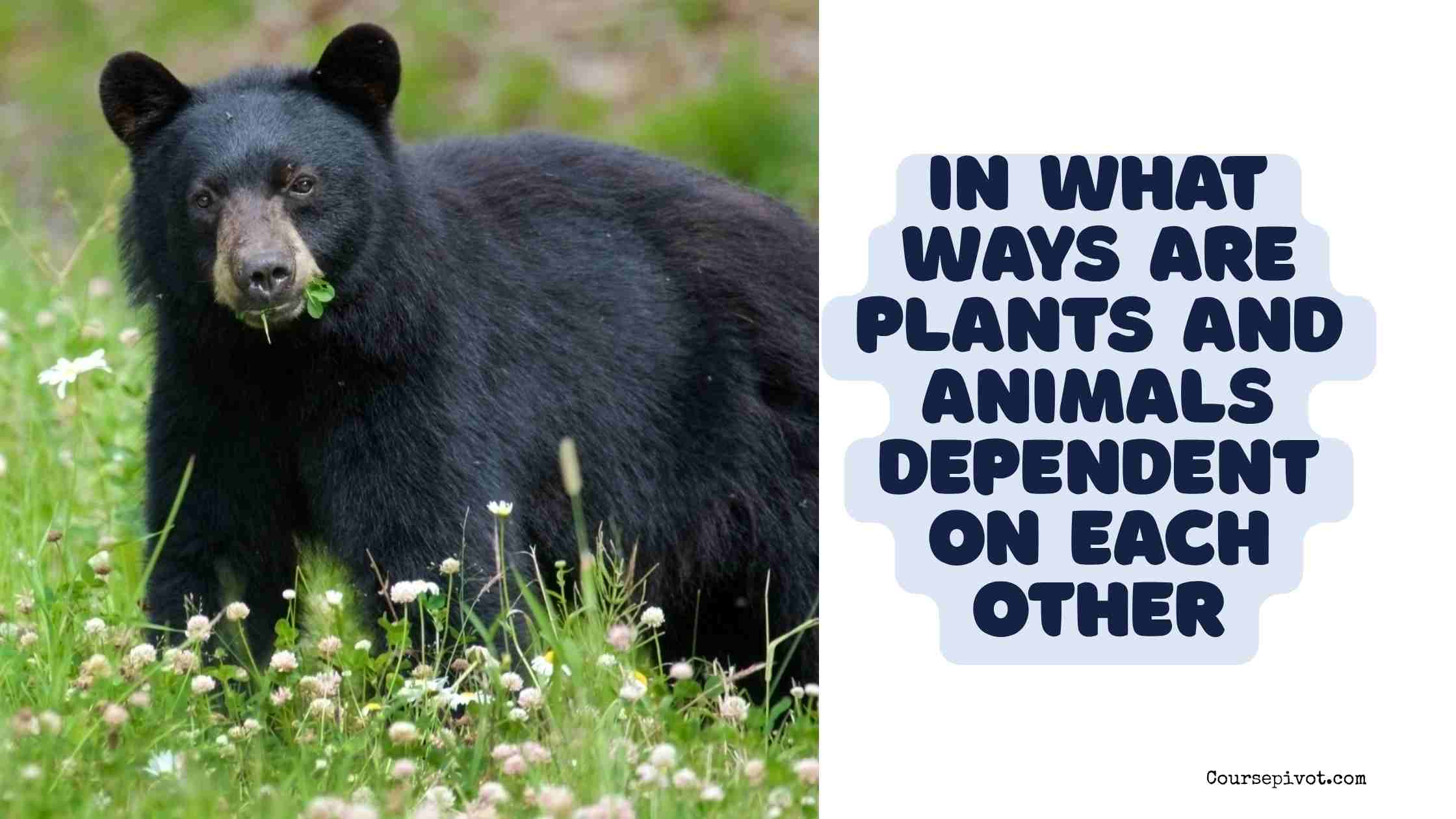
In What Ways Are Plants and Animals Dependent on Each Other?
The relationship between plants and animals is a beautiful dance of survival, where each relies on the other to thrive. This interdependence shapes ecosystems, from lush forests to vibrant coral reefs. I’ve always been fascinated by how nature balances these connections—like bees pollinating flowers or trees providing oxygen for us to breathe. Have you ever stopped to think how deeply plants and animals need each other? It’s a web of life that’s both intricate and essential.
Table of Contents
When I walk through a park, I see this partnership everywhere: squirrels nibbling on nuts from trees, birds nesting in branches, and flowers blooming thanks to insect visitors. In this article, I’ll explore 10 ways plants and animals are dependent on each other, drawing from biology, personal observations, and ecological insights to highlight their mutual reliance.
This topic matters because these relationships sustain life on Earth, including our own. Understanding them deepens our appreciation for nature and informs conservation efforts. Ready to dive into this vital connection? Let’s uncover how plants and animals keep each other alive.
By the end, you’ll see the profound ways they intertwine and why protecting both is crucial. Let’s start with one of the most fundamental exchanges—oxygen and carbon dioxide.
Understanding Plant-Animal Interdependence
Plants and animals are interconnected through ecological relationships that ensure survival and balance in ecosystems. These dependencies include mutualism (both benefit), commensalism (one benefits, the other is unaffected), and even indirect interactions. Key processes like photosynthesis, pollination, and nutrient cycling tie their fates together. Why is this so critical? Without these relationships, ecosystems would collapse, affecting food chains, climate, and biodiversity.
Now, let’s explore 10 ways plants and animals depend on each other, showing the depth of their bond.
10 Ways Plants and Animals Are Dependent on Each Other
1. Oxygen-Carbon Dioxide Exchange
Plants produce oxygen through photosynthesis, which animals need to breathe, while animals exhale carbon dioxide, which plants use to make food.
- How it works: Plants convert CO₂ and sunlight into glucose and oxygen; animals inhale oxygen for cellular respiration, releasing CO₂.
- Example: Humans and other mammals rely on trees like oaks for oxygen, while trees use our exhaled CO₂.
- My take: I breathe easier in a forest, knowing trees are literally giving me life. It’s humbling.
- Impact: This cycle sustains nearly all life, with plants producing about 50% of Earth’s oxygen, per NASA studies.
Without each other, neither could survive long-term.
2. Pollination by Animals
Many plants depend on animals like bees, butterflies, and birds for pollination, transferring pollen to reproduce and produce seeds.
- How it works: Pollinators visit flowers for nectar, spreading pollen between plants.
- Example: Bees pollinate apple trees, ensuring fruit production.
- My observation: Watching bees buzz around my garden’s flowers reminds me how vital they are to our food supply.
- Why it matters: About 75% of global crops, like fruits and vegetables, rely on animal pollinators, per the FAO.
Plants get reproduction; animals get food—a perfect partnership.
3. Seed Dispersal by Animals
Animals help plants spread their seeds, ensuring new growth in diverse areas, while plants provide food or resources in return.
- How it works: Animals eat fruit and excrete seeds elsewhere, or carry seeds on fur, like squirrels burying acorns.
- Example: Birds like sparrows eat berries and drop seeds far from the parent plant.
- My story: I found a sapling in my yard, likely from a bird’s seed drop. Nature’s delivery system!
- Impact: Seed dispersal maintains forest and grassland diversity, per a 2023 Ecology study.
Animals expand plant populations; plants feed or shelter them.
4. Food Chain Dependency
Plants are primary producers, forming the base of the food chain, while animals rely on them directly (herbivores) or indirectly (carnivores).
- How it works: Plants convert sunlight into energy; herbivores like deer eat plants; predators like wolves eat herbivores.
- Example: Grass feeds rabbits, which feed foxes.
- My reflection: Seeing deer graze in a meadow shows how plants are the foundation of life.
- Why it’s key: Plants support 80% of terrestrial food chains, per the National Academy of Sciences.
Without plants, animals starve; without animals, ecosystems lose balance.
5. Habitat Provision
Plants provide habitats—shelter, nesting sites, and protection—for countless animals, while animals help maintain these habitats.
- How it works: Trees, shrubs, and grasses offer homes; animals like birds spread seeds to sustain these environments.
- Example: Coral reefs (built by plant-like algae) house fish, while birds nest in mangroves.
- My take: I’ve watched squirrels scamper up oaks, perfectly at home. Plants are their safe haven.
- Impact: Forests and wetlands support 50% of global biodiversity, per WWF data.
Plants give animals a home; animals ensure plant survival.
6. Nutrient Cycling
Animals contribute to nutrient cycling by decomposing organic matter or depositing waste, enriching soil for plant growth.
- How it works: Animal waste (e.g., manure) and remains fertilize soil; plants absorb these nutrients to grow.
- Example: Earthworms aerate soil, helping grass thrive, while cow manure fertilizes crops.
- My observation: My compost pile, boosted by kitchen scraps and worm activity, grows the best tomatoes.
- Why it matters: Nutrient cycling supports 90% of plant growth in natural ecosystems, per a 2024 Nature study.
Animals nourish plants; plants sustain animals with food.
7. Pest Control by Animals
Animals like birds, bats, and insects control pests that harm plants, protecting crops and forests in a natural balance.
- How it works: Predators eat pests, like ladybugs consuming aphids or owls hunting rodents.
- Example: Bats eat moths that damage corn crops.
- My story: A bird feeder in my yard attracted sparrows that kept my plants bug-free. Nature’s pest control!
- Impact: Biological pest control saves $13 billion annually in U.S. agriculture, per USDA estimates.
Animals protect plants; plants provide food and habitat in return.
8. Plants as Medicine for Animals
Some animals rely on plants for medicinal purposes, using leaves or bark to treat ailments, while plants benefit from animal interaction.
- How it works: Animals like chimpanzees eat specific plants to combat parasites; their movement spreads plant seeds.
- Example: Elephants chew willow bark, which has pain-relieving properties.
- My reflection: I read about monkeys using herbs for health—it’s like nature’s pharmacy.
- Why it’s key: Ethnobotany studies show 25% of animal species use medicinal plants.
Plants heal animals; animals aid plant dispersal.
9. Mutualistic Relationships
Certain plants and animals have mutualistic relationships, where both directly benefit, like ants protecting acacia trees or mycorrhizal fungi aiding roots.
- How it works: Ants defend acacias from herbivores, getting nectar in return; fungi enhance plant nutrient uptake, receiving sugars.
- Example: Clownfish live in sea anemones (plant-like animals), protecting them while gaining shelter.
- My take: Watching ants march up a tree to guard it feels like a tiny alliance in action.
- Impact: Mutualism supports 30% of terrestrial ecosystems, per a 2023 Science study.
Both thrive through this give-and-take.
10. Climate Regulation
Plants and animals work together to regulate climate, with plants absorbing CO₂ and animals aiding carbon storage through their interactions.
- How it works: Forests store carbon; animals like beavers create wetlands that trap CO₂, while grazing animals promote grass growth.
- Example: Bison grazing stimulates prairie grasses, which sequester carbon.
- My observation: Visiting a wetland, I saw how beaver dams created lush habitats that fight climate change.
- Why it matters: Plant-animal interactions offset 15% of global emissions, per IPCC reports.
Together, they maintain a habitable planet.
Why This Interdependence Matters
These ways plants and animals are dependent on each other—oxygen exchange, pollination, seed dispersal, food chains, habitats, nutrient cycling, pest control, medicinal plants, mutualism, and climate regulation—form the backbone of ecosystems. Have you noticed these connections in your own backyard? They’re vital because they sustain biodiversity, food security, and environmental stability. A 2024 Nature Ecology study warns that disrupting these relationships, like through deforestation or pollinator loss, could collapse 40% of ecosystems.
Read our blog on Why Water Used by Plants and Animals Today Has Been Around for Millions of Years
Challenges to Plant-Animal Relationships
Threats like climate change, habitat loss, and pollution strain these dependencies:
- Pollinator decline: Pesticides kill bees, threatening 35% of global crops.
- Deforestation: Loss of trees displaces animals, breaking seed dispersal cycles.
- My concern: I’ve seen fewer bees in my garden lately, worrying me about local plants.
- Impact: Biodiversity loss reduces ecosystem resilience, per WWF data.
Protecting these relationships is critical for survival.
How to Support Plant-Animal Interdependence
You can help maintain these connections:
- Plant native species: Attract pollinators and birds with local flowers or trees.
- Reduce pesticides: Use natural pest control to protect beneficial insects.
- Support conservation: Donate to or volunteer with groups like the Nature Conservancy.
- My tip: I planted milkweed for monarch butterflies—it’s rewarding to see them visit.
Small actions strengthen this vital web.
Summarized Answer
In what ways are plants and animals dependent on each other? Plants and animals are dependent on each other in 10 key ways: oxygen-carbon dioxide exchange, pollination by animals, seed dispersal, food chain support, habitat provision, nutrient cycling, pest control, plants as medicine, mutualistic relationships, and climate regulation. These interactions, like bees pollinating flowers or animals fertilizing soil, ensure survival, biodiversity, and ecosystem balance. Backed by ecological research, these dependencies highlight the critical need to protect both plants and animals for a thriving planet.



